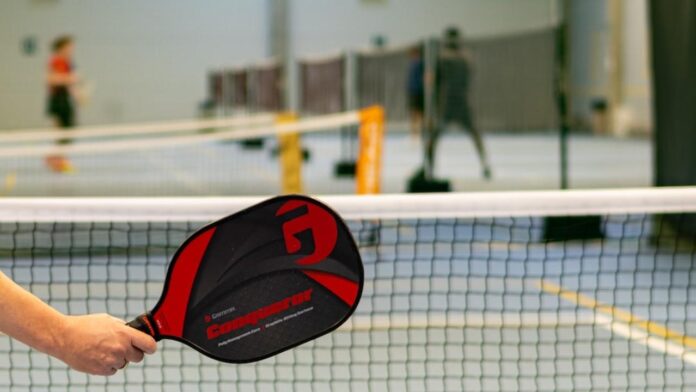Table of Contents
Introduction
Pickleball is a relatively new sport that has gained popularity both domestically and internationally. It offers players of all ages and ability levels a distinctive and thrilling experience by fusing aspects of tennis, badminton, and ping pong. The history of pickleball, its regulations, its rising popularity, and the reasons you might think about picking up a paddle and joining the fun are all covered in this article.
History of Pickleball
In the summer of 1965, pickleball was developed on Bainbridge Island in Washington. According to the legend, businessman Bill Bell and congressman Joel Pritchard were seeking for something to do to amuse their family on a hot summer day. Ping pong paddles, a perforated plastic ball, and a badminton net were used to create a game on the spot. The game immediately became well-liked among their family and friends, and pickleball was formally established as a sport.
The origin of the term “pickleball” is intriguing. Some people think the dog owned by the Pritchards, Pickles, who was well known for chasing the ball during games, inspired the name. Others assert that the name was inspired from the “pickle boat,” a rowing phrase for a boat made up of extra rowers. Regardless of where the term came from, pickleball started to take off outside of Bainbridge Island and eventually became nationwide.
The game’s rules
A pickleball court is rectangular and about the same size as a badminton court. At the sides, the net is 36 inches high, while in the middle, it is 34 inches high. The more popular variant is doubles, but it may also be played in singles.
Here are some essential pickleball guidelines:
Serving: The server should be positioned diagonally across from the receiver, behind the baseline. The ball must clear the net and settle inside the other team’s service court for the serve to be considered successful. In pickleball, as opposed to tennis, you only receive one serve attempt.
Double-Bounce Regulation: Following the serve, both sides must wait for the ball to land on either side once before volleying (striking the ball in the air). This regulation encourages longer rallies and tactical movement.
Non-Volley Zone: The non-volley zone (also known as the “kitchen”) is the space directly in front of the net that extends seven feet on either side of the net. While in this area, players are not permitted to volley (strike the ball in the air). They can go into the zone to play a ball that has bounced there, but they have to leave before volleying.
Scoring: Pickleball is usually played to a score of 11 or 21, and in order to win, you must have a minimum of two points in your favor. The server must announce the score before every serve. Only the serving team is allowed to score.
Increased Popularity
The game of pickleball has become increasingly popular recently for a number of reasons:
Accessibility: Pickleball’s popularity is largely due to its accessibility. It is a year-round sport that may be played in a number of locations, including indoor gyms and special outdoor courts. The learning curve is not as severe as in some other sports, and the regulations are quite straightforward.
All Ages and Skill Levels: Pickleball is a sport that may be enjoyed by players of all ages and ability levels. Pickleball may meet your needs whether you’re a novice searching for a fun way to remain healthy or an experienced athlete seeking a new challenge.
Social Aspect: Pickleball is a social sport that promotes communication and teamwork among participants. It’s a fantastic way to network, establish friends, and create a sense of belonging.
Fitness Benefits: Pickleball has several health benefits, including improving agility, hand-eye coordination, and cardiovascular fitness. It’s an enjoyable method to keep healthy and fit.
Low Equipment Costs: Unlike some sports, pickleball doesn’t require a lot of pricey equipment. All you need are some pickleballs, which you can get for not too much money, and a paddle.
Why Pickleball Should Be Considered
Here are some strong arguments to pick up a paddle if you’re still debating
Enjoyable Physical Activity: Pickleball is a ton of fun and provides a great workout. It’s a fantastic method to move more, burn calories, and increase your fitness level in general.
Social Engagement: Pickleball is a sport that promotes a sense of community, which is social engagement. You may take part in competitions, join neighborhood groups, and meet others who are as enthusiastic about the sport as you are.
Mental Stimulation: Pickleball is not only physically hard, but it also involves rapid thinking and intelligent decision-making. It keeps your brain active and alert.
Low-effect Sport: Pickleball is a fantastic choice if you’re worried about the effect on your joints. Compared to sports like jogging or high-intensity training, it is a low-impact activity that is kinder to the body.
Competitive Opportunities: Pickleball provides a variety of competitive options, ranging from friendly matches with friends to serious competitions at the local, national, and international levels.
Conclusion
Pickleball is more than simply a game; it’s a rising social movement that encourages exercise and provides a fun and interesting way to keep in shape. It’s understandable why pickleball is gaining popularity among individuals of different ages and backgrounds given its accessibility and inclusion. So why not try it out? Pick up a paddle, find a pickleball court nearby, and experience the thrill of this fun sport for yourself. Pickleball’s special combination of athleticism and companionship could just have you hooked.


